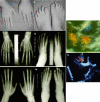A possible new syndrome with double endocrine tumors in association with an unprecedented type of familial heart-hand syndrome: a case report
- PMID: 21034446
- PMCID: PMC2987961
- DOI: 10.1186/1752-1947-4-347
A possible new syndrome with double endocrine tumors in association with an unprecedented type of familial heart-hand syndrome: a case report
Abstract
Introduction: The combination of a pituitary prolactinoma and an aldosterone-producing adrenal adenoma is extremely rare. To the best of our knowledge, double endocrine tumors in association with heart-hand syndrome have not previously been reported.
Case presentation: A 21-year-old Japanese woman presented with galactorrhea and decreased visual acuity. A large pituitary adenoma with an increased level of serum prolactin was apparent by computed tomography. She additionally showed mild hypertension (136/90 mmHg) accompanied by hypokalemia. The plasma aldosterone concentration was increased. Computed tomography showed a mass in the right adrenal gland. No other tumors were found despite extensive imaging studies. Physical and radiographic examinations showed skeletal malformations of the hands and feet, including hypoplasia of the first digit in all four limbs. An atrial septal defect was demonstrated by echocardiography. Similar digital and cardiac abnormalities were detected in our patient's father, and a clinical diagnosis of hereditary heart-hand syndrome was made.
Conclusion: No established heart-hand syndrome was wholly compatible with the family's phenotype. Her father had no obvious endocrine tumors, implying that the parent of transmission determined variable phenotypic expression of the disease: heart-hand syndrome with multiple endocrine tumors from the paternal transmission or no endocrine tumor from the maternal transmission. This suggests that the gene or genes responsible for the disease may be under tissue-specific imprinting control.
Figures


Similar articles
-
Pituitary prolactinoma, adrenal aldosterone-producing adenomas, gastric schwannoma and colonic polyadenomas: a possible variant of multiple endocrine neoplasia (MEN) type I.Acta Endocrinol (Copenh). 1982 Jun;100(2):189-95. doi: 10.1530/acta.0.1000189. Acta Endocrinol (Copenh). 1982. PMID: 7113590
-
An Interesting Case of Hepatic Adrenocortical Carcinoma.Acta Med Indones. 2018 Jul;50(3):257-259. Acta Med Indones. 2018. PMID: 30333277
-
Prolactinoma in a Dog.Vet Pathol. 2017 Nov;54(6):972-976. doi: 10.1177/0300985817726118. Epub 2017 Aug 16. Vet Pathol. 2017. PMID: 28812531
-
[Unilateral exophthalmos caused by a prolactin producing ectopic pituitary adenoma: case report].No Shinkei Geka. 2002 Jun;30(6):623-8. No Shinkei Geka. 2002. PMID: 12094689 Review. Japanese.
-
Idiopathic granulomatous hypophysitis presenting with galactorrhea, headache, and nausea in a woman: a case report and review of the literature.J Med Case Rep. 2019 Nov 16;13(1):334. doi: 10.1186/s13256-019-2276-4. J Med Case Rep. 2019. PMID: 31731892 Free PMC article. Review.
Cited by
-
Clinical and epidemiological features of heart-hand syndrome, an updated analysis in China.BMC Musculoskelet Disord. 2020 Nov 25;21(1):777. doi: 10.1186/s12891-020-03813-1. BMC Musculoskelet Disord. 2020. PMID: 33238988 Free PMC article.
-
Normotensive presentation in primary aldosteronism: A report of two cases.J Renin Angiotensin Aldosterone Syst. 2021 Jan-Dec;22(1):14703203211003780. doi: 10.1177/14703203211003780. J Renin Angiotensin Aldosterone Syst. 2021. PMID: 33749373 Free PMC article.
-
Rare Case of Ulnar-Mammary-Like Syndrome With Left Ventricular Tachycardia and Lack of TBX3 Mutation.Front Genet. 2018 Jun 15;9:209. doi: 10.3389/fgene.2018.00209. eCollection 2018. Front Genet. 2018. PMID: 29963074 Free PMC article.
References
-
- Basson CT, Solomon SD, Weissman B, MacRae CA, Poznanski AK, Prieto F, Ruiz de la Fuente S, Pease WE, Levin SE, Holmes LB, Seidman JG, Seidman CE. Genetic heterogeneity of heart-hand syndromes. Circulation. 1995;91(5):1326–1329. - PubMed
-
- Li QY, Newbury-Ecob RA, Terrett JA, Wilson DI, Curtis AR, Yi CH, Gebuhr T, Bullen PJ, Robson SC, Strachan T, Bonnet D, Lyonnet S, Young ID, Raeburn JA, Buckler AJ, Law DJ, Brook JD. Holt-Oram syndrome is caused by mutations in TBX5, a member of the Brachyury (T) gene family. Nat Genet. 1997;15(1):21–29. doi: 10.1038/ng0197-21. - DOI - PubMed
-
- Temtamy SA, McKusick VA. The genetics of hand malformations. Birth Defects Orig Artic Ser. 1978;14(3):1–619. - PubMed
LinkOut - more resources
Full Text Sources

